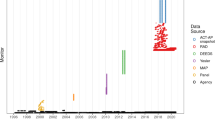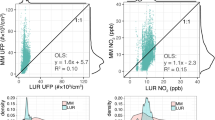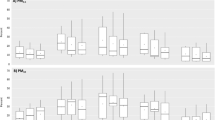Abstract
Land use regression (LUR) is a method for predicting the spatial distribution of traffic-related air pollution. To facilitate risk and exposure assessment, and the design of future monitoring networks and sampling campaigns, we sought to determine the extent to which LUR can be used to predict spatial patterns in air pollution in the absence of dedicated measurements. We evaluate the transferability of one LUR model to two other geographically comparable areas with similar climates and pollution types. The source model, developed in 2003 to estimate ambient nitrogen dioxide (NO2) concentrations in Vancouver (BC, Canada) was applied to Victoria (BC, Canada) and Seattle (WA, USA). Model estimates were compared with measurements made with Ogawa® passive samplers in both cities. As part of this study, 42 locations were sampled in Victoria for a 2-week period in June 2006. Data obtained for Seattle were collected for a different project at 26 locations in March 2005. We used simple linear regression to evaluate the fit of the source model under three scenarios: (1) using the same variables and coefficients as the source model; (2) using the same variables as the source model, but calculating new coefficients for local calibration; and (3) developing site-specific equations with new variables and coefficients. In Scenario 1, we found that the source model had a better fit in Victoria (R2=0.51) than in Seattle (R2=0.33). Scenario 2 produced improved R2-values in both cities (Victoria=0.58, Seattle=0.65), with further improvement achieved under Scenario 3 (Victoria=0.61, Seattle=0.72). Although it is possible to transfer LUR models between geographically similar cities, success may depend on the between-city consistency of the input data. Modest field sampling campaigns for location-specific model calibration can help to produce transfer models that are equally as predictive as their sources.
This is a preview of subscription content, access via your institution
Access options
Subscribe to this journal
Receive 6 print issues and online access
$259.00 per year
only $43.17 per issue
Buy this article
- Purchase on Springer Link
- Instant access to full article PDF
Prices may be subject to local taxes which are calculated during checkout




Similar content being viewed by others
References
Brauer M., Hoek G., Smit H.A., de Jongste J.C., Gerritsen J., Postma D.S., Kerkhof M., and Brunekreef B. Air Pollution and the development of asthma, allergy and infections in a birth cohort. Eur Respir J 2007: 29: 879–888.
Brauer M., Hoek G., van Vliet P., Meliefste K., Fischer P., Gehring U., Heinrich J., Cyrys J., Bellander T., Lewne M., and Brunekreef B. Estimating long-term average particulate air pollution concentrations: application of traffic indicators and geographic information systems. Epidemiology 2003: 14 (2): 228–239.
Brauer M., Hoek G., Van Vliet P., Meliefste K., Fischer P.H., Wijga A., Koopman L.P., Neijens H.J., Gerritsen J., Kerkhof M., Heinrich J., Bellander T., and Brunekreef B. Air pollution from traffic and the development of respiratory infections and asthmatic and allergic symptoms in children. Am J Respir Crit Care Med 2002: 166 (8): 1092–1098.
Briggs D., Collins S., Elliott P., Fischer P., Kingham S., Lebret E., Pryl K., Reeuwijk H.V., and Smallbone K. Mapping urban air pollution using GIS: a regression-based approach. Int J Geogr Inf Sci 1997: 11: 669–718.
Briggs D., de Hoogh C., Gulliver J., Wills J., Elliott P., Kingham S., and Smallbone K. A regression-based method for mapping traffic-related air pollution: application and testing in four contrasting urban environments. Sci Total Environ 2000: 253: 151–167.
Brunekreef B., and Holgate S.T. Air pollution and health. Lancet 2002: 360 (9341): 1233–1242.
Cohen M., Allen R., Gould T., Adar S., Hardie D., Kaufman J., Larson T., and Hinckley-Stukovsky K. Multi-Ethnic Study of Atherosclerosis—Air Pollution (MESA Air Pollution): Exposure Assessment Methodology. In press, spring, 2007.
Cyrys J., Hochadel M., Gehring U., Hoek G., Diegmann V., Brunekreef B., and Heinrich J. GIS-based estimation of exposure to particulate matter and NO2 in an urban area: stochastic versus dispersion modeling. Environ Health Perspect 2005: 113 (8): 987–992.
Gauderman W., Avol E., Lurmann F., Kuenzli N., Gilliland F., Peters J., and McConnel R. Childhood asthma and exposure to traffic and nitrogen dioxide. Epidemiology 2005: 16 (6): 737–743.
Gilbert N., Goldberg M., Beckerman B., Brook J., and Jerrett M. Assessing spatial variability of ambient nitrogen dioxide in Montréal, Canada, with a land-use regression model. J Air Waste Manag Assoc 2005: 55: 1059–1063.
Gonzales M., Qualls C., Hudgens E., and Neas L. Characterization of a spatial gradient of nitrogen dioxide across a United States-Mexico border city during winter. Sci Total Environ 2005: 337 (1–3): 163–173.
Henderson S.B., Beckerman B., Jerrett M., and Brauer M. Application of land use regression to estimate long-term concentrations of traffic-related nitrogen oxides and fine particulate matter. Environ Sci Technol 2007: 41: 2422–2428.
Hochadel M., Heinrich J., Gehring U., Morgenstern V., Kuhlbusch T., Link E., Wichmann H., and Krämer U. Predicting long-term average concentrations of traffic-related air pollutants using GIS-based information. Atmos Environ 2006: 40: 542–553.
Hoek G., Brunekreef B., Goldbohm S., Fischer P., and van den Brandt P.A. Association between mortality and indicators of traffic-related air pollution in the Netherlands: a cohort study. Lancet 2002a: 360 (9341): 1203–1209.
Hoek G., Meliefste K., Cyrys J., Lewné Brauer M., Fischer P., Gehring U., van Vliet P., Heinrich J., Bellander T., and Brunekreef B. Spatial variability of fine particle concentrations in three European countries. Atmos Environ 2002b: 36: 4077–4088.
Jenness J. Random point generator (randpts.avx) extension for ArcView 3.x, v 1.3. Jenness Enterprises, 2005 Available at: http://www.jennessent.com/arcview/random_points.htm.
Jerrett M., Arain A., Kanaroglou P., Beckerman B., Crouse D., Gilbert N., Brook J., Finkelstein N., and Finkelstein M. Modeling the intraurban variability of ambient traffic pollution in Toronto, Canada. J Toxicol Environ Health A 2007: 70: 200–212.
Jerrett M., Arain A., Kanaroglou P., Beckerman B., Potoglou D., Sahsuvaroglou T., Morrison J., and Giovis C. A review and evaluation of intraurban air pollution exposure models. J Expo Anal Environ Epidemiol 2005: 15: 185–204.
Kanaroglou P., Jerrett M., Morrison J., Beckerman B., Arain M.A., Gilbert N., and Brook J. Establishing an air pollution monitoring network for intra-urban population exposure assessment; a location-allocation approach. Atmos Environ 2005: 39: 2399–2409.
Krzyzanowski M., Kuna-Dibbert B., and Schneider J., (eds) Health effect of transport related air pollution. Report. World Health Organization 2005.
Künzli N., Kaiser R., Medina S., Studnicka M., Chanel O., Filliger P., Herry M., Horak Jr F., Puybonnieux-Texier V., Quénel P., Schneider J., Seethaler R., Vergnaud J.-C., and Sommer H. Public-health impact of outdoor and traffic-related air pollution: a European assessment. Lancet 2000: 356 (9232): 795–801.
Larssen S., Tonnesen D., Clenchaas J., Aarnes M.J., and Arnesen K. A model for car exhaust exposure calculations to investigate health-effects of air-pollution. Sci Total Environ 1993: 134: 51–60.
Lebret E., Briggs D., van Reeuwijk H., Fischer P., Smallbone K., Harssema H., Bohumir K., Gorynski P., and Elliott P. Small area variations in ambient NO2 concentrations in four European areas. Atmos Environ 2000: 34: 177–185.
Mukerjee S., Smith L., Norris G., Morandi M., Gonzales M., Noble C., Neas L., and Ozkaynak A. Field method comparison between passive air samplers and continuous monitors for volatile organic compounds and NO2 in El Paso, Texas, USA. J Air Waste Manag Assoc 2004: 54 (3): 307–319.
Ross Z., English P., Scalf R., Gunier R., Smorodinsky S., Wall S., and Jerrett M. Nitrogen dioxide prediction in Southern California using land use regression modeling: potential for environmental health analyses. J Expo Sci Environ Epidemiol 2006: 16: 106–114.
Ross Z., Jerrett M., Kazuhiko I., Tempalski B., and Thurston G. A land use regression for predicting fine particulate matter concentrations in the New York City region. Atmos Environ 2007: 41: 2255–2269.
Ryan P.H., LeMasters G.K., Biswas P., Levin L., Hu S., Lindsey M., Bernstein D.I., Lockey J., Villareal M., Hershey G.K., and Grinshpun S.A. A comparison of proximity and land use regression traffic exposure models and wheezing in infants. Environ Health Perspect 2007: 115: 278–284.
Sahsuvaroglu T., Arain A., Kanaroglou P., Finkelstein N., Newbold B., Jerrett M., Beckerman B., Brook J., Finkelstein M., and Gilbert N. A land use regression model for predicting ambient concentration of nitrogen dioxide in Hamilton, Ontario, Canada. J Air Waste Manage Assoc 2006: 56: 1059–1069.
Sather M., Slonecker E., Johnson M., Daughtrey H., and Williams D. Evaluation of ogawa passive sampling devices as an alternative measurement method for the nitrogen dioxide annual standard in El Paso, Texas. Environ Monit Assess 2007: 124 (1–3): 211–221.
Smith L., Mukerjee S., Gonzales M., Stallings C., Neas L., Norris G., and Özkaynak H. Use of GIS and ancillary variables to predict volatile organic compound and nitrogen dioxide levels at unmonitored locations. Atmos Environ 2006: 40: 3773–3787.
Statistics Canada. Population and Dwelling Counts for Canada, Provinces and Territories, Census Metropolitan Areas and Census Agglomerations, 2001 and 1996 Census- 100%; available on the Statistics Canada web site. http://www12.statcan.ca/english/census01/products/standard/popdwell/tables.cfm (accessed March 2008).
Wilhelm M., and Ritz B. Local variations in CO and particulate air pollution and adverse birth outcomes in Los Angeles County, California, USA. Environ Health Perspect 2005: 113 (9): 1212–1221.
Wu J., Lurmann F., Winer A., Lu R., Turco R., and Funk T. Development of an individual exposure model for application to the Southern California children's health study. Atmos Environ 2005: 39: 259–273.
Yamada E., Kimura M., Tomozawa K., and Fuse Y. Simple analysis of atmospheric NO2, SO2 and O3 in mountains by using passive samplers. Environ Sci Technol 1999: 33 (23): 4141–4145.
Acknowledgements
We acknowledge Steve Sakiyama and Warren McCormick from the BC Ministry of Environment for financial support as well as for providing data and access to monitoring locations; BC Hydro for the use of utility poles; and David Hardie for analyzing the Ogawa samplers collected in Seattle.
Author information
Authors and Affiliations
Corresponding author
Rights and permissions
About this article
Cite this article
Poplawski, K., Gould, T., Setton, E. et al. Intercity transferability of land use regression models for estimating ambient concentrations of nitrogen dioxide. J Expo Sci Environ Epidemiol 19, 107–117 (2009). https://doi.org/10.1038/jes.2008.15
Received:
Accepted:
Published:
Issue Date:
DOI: https://doi.org/10.1038/jes.2008.15
Keywords
This article is cited by
-
Geospatial determinants of maternal and child exposure to fine particulate matter in Kintampo, Ghana: Levels within the household and community, by surrounding building density and near roadways
Journal of Exposure Science & Environmental Epidemiology (2023)
-
Development of transferable neighborhood land use regression models for predicting intra-urban ambient nitrogen dioxide (NO2) spatial variations
Environmental Science and Pollution Research (2022)
-
Modelling Distribution of External–Internal Trips and Its Intra-region and Inter-region Transferability
Arabian Journal for Science and Engineering (2019)
-
Development of land use regression models for nitrogen dioxide, ultrafine particles, lung deposited surface area, and four other markers of particulate matter pollution in the Swiss SAPALDIA regions
Environmental Health (2016)
-
Within- and between-city contrasts in nitrogen dioxide and mortality in 10 Canadian cities; a subset of the Canadian Census Health and Environment Cohort (CanCHEC)
Journal of Exposure Science & Environmental Epidemiology (2015)



